| Brazilian Social Democracy Party Partido Social Democracia Brasileira | |
|---|---|
 | |
| President | Yeda Crusius (Since 2020) |
| Founded | 25 June 1988 |
| Headquarters | São Paulo, São Paulo (1988 - 1990) Brasilia, DF (since 1990) |
| Newspaper | Tucanos Pelo Brasil! |
| Membership (2022) | ▼9,595,333 |
| Ideology | Liberal conservatism Social liberalism Big tent Minority: Christian democracy Social democracy Social Conservatism |
| Political position | Centre-right |
| International affiliation | International Democratic Centrist |
| Official colours | Blue Yellow |
| Governor | 14 / 28 |
| Mayor | 2,002 / 5,568 |
| Federal Consulate | 233 / 513 |
| Seat Senate | 35 / 81 |
| State Deputies | 410 / 1,024 |
| Alderman | 24,747 / 56,810 |
| Election symbol | |
 | |
| Party flag | |
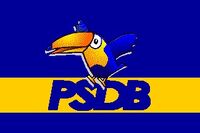 | |
Brazilian Social Democracy Party (Portuguese: Partido Social Democracia Brasileira; PSDB) is a Brazilian center-right political party. It arose from the combination of social democracy, Christian democracy and economic and social liberalism. It was founded on June 25, 1988 by ex-governor Mario Covas (at the time, senator) and Fernando Henrique Carodoso. Its symbol is a toucan in blue and yellow colors: for this reason, its members are eventually called "toucans", and rarely "peessedebistas". Its electoral code is ''45''.
It is the largest political party in Brazil, with more than 6 million members. He grew up around the 2000s after the re-election of Fernando Henrique Cardoso. He dominates most of the seats in the Chamber of Deputies and in the Senate. Among the Government of Alencar (2007 - 2015) it was considered as the biggest opposition of the Petista government, even making accusations of Fraud in magazines in the country.
The Party is the biggest representative of the assembly in the chamber of the people and the senate. In addition to being the party with more governors, mayors and councilors. In the 2020 Municipal elections, the party elected 14 capitals, mainly: São Paulo, Rio de Janeiro, Belo Horizonte and Salvador.
History[]
Dissent of the PMDB and the PSDB Foundation[]
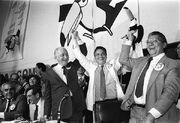
Franco Montoro, FHC and Mario Covas after party foundation
With the imminent collapse of the military dictatorship in the early 1980s, a group of left-wing intellectuals were mobilized to create a leftist party. Some of them attempted to work with the labour movement led by Luiz Inacio Lula da Silva, but the group split over ideological grounds. A group of democratic socialists and Trotskyists joined the labour movement and founded the Workers' Party (PT) while the social democrats remained in the Brazilian Democratic Movement Party (PMDB) and would later create the Brazilian Social Democracy Party.
A high proportion of the first members of the PSDB came from the so-called "historic PMDB", which was and still is a very large party with many internal conflicts. The founders of the PSDB were dissatisfied with the results of the National Constitutional Assembly and decided to create a party to reflect the need for a national political renewal. Some of the founding members were José Serra, Mário Covas, André Franco Montoro, Fernando Henrique Cardoso, Aécio Neves and Geraldo Alckmin.
The name "PSDB" (then "Partido Social Democracia Brasileiro") is suggested for the first time for a new party derived from the MUP in October 1987, in a supra-party meeting that brought together the MUP, PSB and other left and center politicians - left, including deputy Paulo Ramos (PMDB-RJ) and Florestan Fernandes, the former FHC professor.
The PSDB is one of the largest and most significant political parties in Brazil. Its official program says its policies are social democratic and often associated with the Third Way movement, although the party is also seen as influenced by neoliberalism.
Sarney Government and 1989 Election[]

Fernando Henrique Cardoso and José Serra during the Constituent Assembly
The Sarney Government base parties, the PFL and the PMDB, tried to omit the real results of the Cruzado Plan until the 1986 election, which gave them great success in the face of the short-term effects that seemed to solve the monetary calamity. However, shortly after the election, the climate of economic deterioration and hyperinflation become evident to the electorate and public opinion is quickly structured in vehement discredit by traditional politicians. However, the MDB ended up running the popular Itamar Franco for president, making it very difficult to win or stay in the second round in the elections.
PSDB launched Mário Covas and none of the three manages to capitalize on much political success: the PFL and the PMDB due to their role in the Sarney Government, and the PSDB in the face of Fernando Collor de Mello's populist charisma.
In 4th place in the dispute, collecting 13.96% of the votes, the PSDB was initially discarded as a promising party, even more after the dramatic reduction of the Tucana bench that had 60 deputies in the first place and increased to 40. In addition, in the General Elections From 1990. espite having supported the PTB's Brizola candidacy in the second round of the 1989 majority, the PSDB approached the Franco Government in its economic program of privatization, modernization and opening to the outside, but did not integrate the Government base.
Despite having asked in the elections, the PSDB managed to win more than 2 Brazilian states in the state elections, being Ciro Gomes in Ceará and Mario Covas in São Paulo.
The PSDB in the Itamar Franco Government (1990-1999)[]
With the inauguration of the Itamar Franco Government, the PSDB is part of the governing base. When Itamar Franco assumed the presidency of the republic, there was a national unity coalition in the congress to support the new president: PMDB, PT, PFL and PSDB, the biggest parties, waved support. Subsequently, the PT withdrew, this conflict being the reason for Luiza Erundina's departure from the party, as she had been appointed minister.
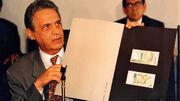
Fernando Henrique Cardoso Introducing the Real Plan
Itamar Franco ended up appointing Fernando Henrique Cardoso (FHC) as his Minister of Economy, which made a great and strong coalition between the MDB and PSDB.
With a small inflation caused by the Sarney government, Minister Fernando Henrique ended up initiating the Real Plan. The Real Plan, elaborated mainly by Edmar Bacha, began to take on clear features with the approval by the National Congress of the "emergency social fund", which would give the government the freedom to dispose of 15% to 20% and to recover the economy that it was already in crisis.
The biggest facet of the Real plan was the Real Value Unit (URV), which acted as a monetary index, converting prices into a new unit that would replace the currency then in force, Cruzeiro Real, with a new currency soon after, the Real. It was the password to get the people used to a new world, before the real currency arrived and to overcome, after more than twenty years, the inflationary culture of the Brazilian.
Election 1994[]

Tasso Jereissati
With the success of Plano Real, the PSDB ended up gaining popularity and making money, which made FHC a possible candidate against Franco in the 1994 elections. However, Fernando decided to stay in the government of Itamar.
In the 1994 elections, the PSDB did not have many oppositions and great candidates for the elections against President Itamar Franco, since PSDB was the MDB ally. The governor of Ceará, Tasso Jereissati, ended up running for the elections to represent the Party. Next on election days, the Party was half divided between supporters of the Itamar Franco government and those who were against the government, the vast majority were supporters, this made the Jereissati candidacy weak. The Candidate ended up in second place with 10 million votes in the first round, a number of votes greater than Mario Covas. The Party eventually returned to the relationship between the Franco government.
Political Crisis and Party Division
After the inauguration of President Itamar Franco's second term, cases of political crisis began to grow in the country, causing several parties to divide. As in the 1994 elections, PSDB was divided between pro-government and anti-government.
The PSDB and the PMDB were affected by this crisis until FHC took office as party president, improving and withdrawing anti-government, about 10,500 members left in less than 5 months. With the growth in the country's economy, the PSDB began to emerge from the political crisis.
Election 1998 and Government FHC (1999-2007)[]

FHC in 1999
With a high popularity due to the Real Plan and the Party organization, Fernando Henrique Cardoso (FHC), it disputed the 1998 elections, ended up winning in the first round with 53.32% of the valid votes FHC ended up taking office in March 1999, being the second president elected after the 1988 re-democratization.
FHC had 2 terms of office (1999 to 2003 and 2003 to 2007) , Throughout the toucan presidential term, the growth of the Brazilian economy was 4.3% per year, which is a surprising number for the economy. There have been numerous privatizations throughout his term.
In international matters, the FHC government was marked by the invasion of French Guiana, an invasion that had the objective of influencing the force in Guyana. This caused international uprisings and the government was Genocide's nickname for the opposition.
Pioneering social programs were created, such as Bolsa-escola, Auxílio-Gás and Bolsa-Comida (subsequently merged into one program, Bolsa Família, by the Alencar Government), in addition to the beginning of State reform, with the implementation, for example, of the Ministry of Defense, the Attorney General's Office (AGU) and the Office of the Comptroller General (CGU).
Merger with the PFL (2003)[]

PFL
The President of the PFL decided that he would merge with the PSDB (the party that governed the country with FHC). The possible merger began because of the high alliance and friendship between the two parties, which made the PFL join the PSDB. President Fernando Henrique Cardoso said in an interview that the union ''is a great success for the future of Brazil'' and that ''the PFL was a great party''.
The opposition of the Brazilian parliament saw this union with bad taste, claiming that the union between the PSDB and the PFL was ''only to try to obtain a majority of the legislative power''.
Year of Election and 2006 crisis[]
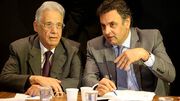
FHC and Aécio Neves in 2010
Another major discontent in the FHC government, was the 2006 crisis, which caused a drop of 2.4% of Brazil's GDP, causing a lot of unemployment. The government used Emergency Aid of 1,300 reais to help people who were unemployed. About 3.6 million Brazilians suffered unemployment and 54 billion reais were spent for emergency aid.
In the same year, presidential elections take place, Vice President Marco Maciel (from PSDB) disputed the governor of mines, José Alencar (from PT). Due to the unpopularity of FHC, José Alencar obtained 51,3% of the valid votes and Marciel 45,55%.
Years of opposition and the Alencar government[]
The inauguration of alencar on March 15 marked the era of the opposition against the PT. Although Alencar had similar ideologies to that of the PSDB, he focused more on the PT and focused on a possible alliance with MDB but he gave up because the alliance was "too risky for the party".
In the 2010 elections, Aécio Neves became a great candidate to challenge President José Alencar. In the first round, the toucan obtained 45.34% and alencar obtained 47.06%. In the second round, the toucan scored 43,38% and the PT 56,62, the first time that a PT was re-elected.
In 2012, in the decision of the Namibian War, the Alencar government was severely criticized for its hypocrisy, because in the 2010 campaign he claimed that Brazil would have peaceful and good relations. The Alencar Government replied that the war would have consequences if Brazil would not have declared war against Namibia.
election, 2014 and the great polarization of the PSDB and PT[]

Aécio Neves with Pimenta da Veiga and Antonio Anastasia in 2014 in the veiga campaign in the mine elections.
In 2014, Aécio Neves had another opportunity to be a big name for the Party in the 2014 elections. Aécio ended up winning by 79.4% of the votes against Onyx Lorenzoni's 15%. The 2014 election marked the great polarization between the PT and the PSDB, with the PSDB being represented by the right and the PT being the left. Due to the polarization, several governors from both parties ran for office, further strengthening the polarization.
Unlike in 2010, the PSDB managed to have a stronger campaign than the previous one, in addition to electoral propaganda being more attacking candidate Haddad than the proposals, drawing more attention.
Aécio Neves obtained 52.5% of the valid votes, while PT petist Haddad obtained 47.25% of the valid votes. In addition to Aécio being elected, 15 PSDB governors were elected, including João Doria (in São Paulo) and Pimenta de Veiga (in Minas Gerais).
Government Aécio Neves (2015-2023)[]
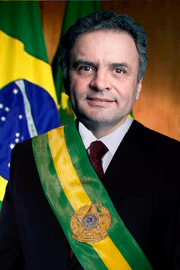
President Aécio Neves in 2016
For the second time, a president of the PSDB takes office as president of Brazil. Like FHC, Neves had two terms (2015 to 2019 and 2019 to 2023). In addition to being the second president of Minas Gerais to be elected after the re-democratization of 1988.
Right at the beginning of his term, due to great polarization, small opposition protests spread throughout the country, and in October he only increased when the government was involved in corruption. The government of Açu Neves was marked by the death and replacement of Aloysio Nunes in November 2015. This ended up resulting in a mini political crisis for Nunes's successor between the governor of São Paulo João Doria and the chairman of the Chamber of Deputies Fábio Ramalho. João Dória ended up winning with a difference of 16 votes difference.
The Aécio Neves Government is known for its large expenditures on sports and international competitions, such as the 2016 Olympics in São Paulo and the 2022 World Cup. With that, it met with harsh criticism for the lack of ''education and schooling across the country''.

President Aécio Neves at the Itamaraty ceremony in 2019
In the 2018 elections, Aécio Neves had many proposals in conservative liberalism, reinforcing moralism with Minha Casa, Minha Família. The PSDB made coalitions in a presidential election, where it did with the PTB. In the first round, Aécio easily managed to beat Manuela d'Ávilla with 53.1% of the votes, while PT's Petista d'Ávila obtained 41.76%, which is the best result of a PSDB candidate.
The Neves government was considered internationally as neutral and easy to market and do business. Making the GDP grow in Brazil very fast, reaching from 3 trillion to 12 trillion in 7 years. Which made the data sheet very advantageous in opinion polls. Some PSDB governors follow some important proposals that the neves government made as the governor of Minas Gerais.
The Government of Aécio Neves was the Brazilian government that hosted the most refugee immigrants in history, around 2015 and 2018. The Plan to shelter refugees refugees was given to the Alencar government at the end of his term, where it only snows in the term that the plan was successfully evaluated. Brazil became the country that sheltered most refugees from America, with 10,000, besides being the ninth in the world.
Election 2022[]
Primaries by the party started in October 2021, 4 months ahead of the expected date (which usually takes place in the election year between February or March). The favorites in the election were Eduardo Leite, a candidate supported by President Aécio Neves who was above the polls, and Mayor Jair Bolsonaro supported by the more conservative wing of the party.

Eduardo Leite and the candidate for the government of Rio Grande do Sul in Pelotas in his campaign
The primary favorite, Eduardo Leite, managed to obtain more than 50% of the valid votes, in an important victory, being elected the candidate for the presidency of his country in 2022. In addition, it was the first time that a Brazilian Southerner was a candidate.
He was made official candidate for the PSDB presidency in July, along with his vice-president Alessandro Vieira. During his presidential campaign, he was called the '' successor of aecio '' by the media, in addition to having some more center-left ideas, despite also having center-right-right ideas. In the first round, he came in first with 45.5% of the valid votes, while the second place, Lula, got 41.9%. Both candidates went to contest the second round, which was the most polarized election in Brazil, much more than in 2010 and 2014.
Through the Chamber of Deputies and the Senate, the PSDB had a significant and even unexpected growth in the last elections, where the party almost obtained an absolute majority in both chambers. Thanks to the alliance with the MDB and UNIÃO, the party got the majority, facilitating governance in the Leite government.
Ideology[]

The Toucan is the biggest symbol of the political party, planned by Franco Montoro since the creation of the political party
Although its name and its initial ideology was social democracy, the party over the years began to change its political positions towards the more right wing. The Brazilian Social Democratic Party is considered by a large part of the electoral public as “center-right” the “Right” and has Liberal Conservatism and liberalism in general as its main ideologies. In some wings of the party, there are social democratic members such as Raquel Lyra and Arthur Virgílio, while in the more liberal and conservative wing there are the various members of the party, which makes the party become a right-wing party respectively.
Within this context, in 2005, interviewed by the PSDB newspaper, Fernando Henrique Cardoso, the party's honorary president, stated that, regardless of the position taken by the PT, the PSDB's position should remain opposed by the PT. FHC stated that, from an ideological point of view, the party could not yield, remaining where it was, continuing with its line "of center-right or center looking to the right".
Presidents of PSDB[]
The party president is elected for a 4-year term, when a president resigns, the interim president stays until the end of a president's term (which he resigned). Franco Montoro and FHC received the title of "president of honor" symbolically.
participation and Electoral performance[]
The PSDB has always maintained an excellent result of the presidential elections. Apart from the 1989 election, toucan candidates always came in second or won the election.
| Year | Imagem | Candidate for President | Vice-Candidate for President | Coalition | Votes | % | Position |
|---|---|---|---|---|---|---|---|
| 1989 | Mário Covas | Almir Gabriel
(PSDB) |
No Coalition | 9,120,346 | 13,96% | 4.º | |
| 1994 | Tasso Jereissati | Pimenta de Veiga
(PSDB) |
União, Trabalho e Progresso
(PSDB, PFL e PTB) |
14,539,846 | 20,64% | 2.º | |
| 1998 | Fernando Henrique Cardoso | Marco Maciel
(PSDB) |
União, Trabalho e Progresso
(PSDB, PFL, PPB, PTB ) |
41,244,754 | 58,77% | 1.º | |
| 2002 | 49,184,742 | 50,04% | 1.º | ||||
| 2006 | Marco Maciel | José Serra
(PSDB) |
Por um Brasil Grande!
(PSDB, PPB, PTB) |
42,582,429 | 45,55% | 2.º | |
| 2010 | Aécio Neves | João Doria
(PSDB) |
O Brasil pode mais!
(PSDB, PRENA, PTB) |
47,930,832 | 43,38% | 2.º | |
| 2014 | Aécio Neves | Aloysio Nunes
(PSDB) |
Um Brasil seguir em frente
(PSDB, PRENA,PTB,PP) |
61,315,902 | 52,5% | 1.º | |
| 2018 | João Doria
(PSDB) |
Um Brasil seguir em frente
(PSDB, PTB, PP) |
63,045,388 | 53,1% | 1.º | ||
| 2022 | Eduardo Leite | Alessandro Vieria
(PSDB) |
Um Brasil da nossa gente
(PSDB, MDB, UNIÃO, PTB, PP, PSDC) |
69,696,334 | 53,92% | 1.º |
Participation in federal parliamentary elections[]
| Legislature | Assents | ± |
|---|---|---|
| 49.ª Lesgilation (1991–1995) | 39 / 513
|
39▲ |
| 50.ª Legislation (1995–1999) | 70 / 513
|
31▲ |
| 51.ª Lesgilation (1999–2003) | 119 / 513
|
49▲ |
| 52.ª Lesgilation (2003–2007) | 170 / 513
|
51▲ |
| 53.ª Lesgilation (2007–2011) | 159 / 513
|
11▼ |
| 54.ª Lesgilation (2011–2015) | 160 / 513
|
1▲ |
| 55.ª Lesgilation (2015–2019) | 195 / 513
|
35▲ |
| 56.ª Lesgilation (2019–2023) | 203 / 513
|
8▲ |
| 56.ª Lesgilation (2023–2027) | 233 / 513
|
30▲ |
| Legislature | Assents | ± |
|---|---|---|
| 49.ª Legislation (1991–1995) | 9 / 81
|
9▲ |
| 50.ª Legislation (1995–1999) | 20 / 81
|
11▲ |
| 51.ª Legislation (1999–2003) | 23 / 81
|
3▲ |
| 52.ª Legislation (2003–2007) | 27 / 81
|
4▲ |
| 53.ª Legislation (2007–2011) | 25 / 81
|
2▼ |
| 54.ª Lesgilation (2011–2015) | 24 / 81
|
1▼ |
| 55.ª Lesgilation (2015–2019) | 30 / 81
|
6▲ |
| 56.ª Lesgilation (2019–2023) | 28 / 81
|
2▼ |
| 57.ª Lesgilation (2023–2027) | 35 / 81
|
7▲ |
| Deputies (States) | AC | AL | AM | AP | BA | CE | DF | ES | GE | GO | MA | MG | MS | MT | PA | PB | PE | PI | PR | RJ | RN | RO | RR | RS | SC | SE | SP | TO |
|---|---|---|---|---|---|---|---|---|---|---|---|---|---|---|---|---|---|---|---|---|---|---|---|---|---|---|---|---|
| 233 | 4 | 4 | 5 | 3 | 3 | 2 | 6 | 7 | 2 | 11 | 3 | 26 | 5 | 7 | 5 | 4 | 8 | 3 | 16 | 20 | 6 | 5 | 5 | 16 | 14 | 4 | 40 | 3 |
| Senates | AC | AL | AM | AP | BA | CE | DF | ES | GE | GO | MA | MG | MS | MT | PA | PB | PE | PI | PR | RJ | RN | RO | RR | RS | SC | SE | SP | TO |
|---|---|---|---|---|---|---|---|---|---|---|---|---|---|---|---|---|---|---|---|---|---|---|---|---|---|---|---|---|
| 35 | 3 | 0 | 1 | 1 | 1 | 0 | 1 | 2 | 0 | 2 | 0 | 3 | 3 | 1 | 2 | 1 | 2 | 0 | 2 | 2 | 0 | 2 | 2 | 1 | 2 | 0 | 2 | 0 |
In 2006, the PSDB elected 25 senators and 159 federal deputies. In addition, they elected 9 governors, among them: Geraldo Alckim (São Paulo), Aécio Neves (Minas Gerais), Yeda Crusius (Rio Grande do Sul), Sério Cabral (Rio de Janeiro) and the other 4 elected governors.
In 2011, the party formed the largest bench in the Chamber, with 160 federal deputies (almost equalizing the PT), and the second largest in the Senate, with eleven 24 elected, with candidate Aloysio Nunes elected Senator from São Paulo with 12 million seats. votes, the biggest vote in history for the Senate.
Municipal Elections[]
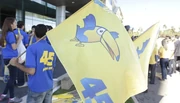
PSDB voter in the 2016 elections. Traditionally, voters wear a blue and yellow shirt (party colors) with voter number 45.
Although newly constituted and still provisionally organized, the PSDB participated in the municipal elections of November 15, 1988, competing with its own candidates and achieving important victories as in Minas Gerais, where it won the prefectures of Belo Horizonte with Pimenta da Veiga, and de Contagem, with Ademir Lucas Gomes, in addition to five other city halls in that state. In Ceará, Ciro Gomes elected the mayor of Fortaleza.
In the 1992 elections, the Brazilian Social Democracy Party won in São Bernardo do Campo, considered the cradle and stronghold of PT, with Maurício Soares. Altogether, it won 842 city halls and elected 4582 city aldermans, generating enormous growth and establishing itself definitively as one of the largest parties in Brazil.
In 2004, for the first time, the PSDB managed to be the party with the most elected mayors and councilors, standing in front of its rival (in municipal elections) PMDB. He elected 1393 mayors and 9,411 aldermans.
In the 2016 elections, PSDB was the first political party since the 1988 re-democratization that elected 2000 mayors, breaking a record in Brazil's municipal elections.
State Directories and Municips[]
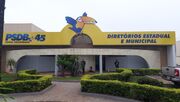
PSDB Board of Directors in Mato Grosso do Sul
Like any party, the PSDB has its various Municipal Directories, including the State ones. The PSDB is the party with the most municipal directories, has more than 2500 municipal chambers nationally commanded by the current President of the party. In the state directories, the main headquarters are in Mato Grosso do Sul, Minas Gerais and São Paulo, where they are the stage for major national conventions of the party.
Thanks to these directories the party was able to easily gain many members. Every 1 month, the party receives 2,700 members.
In 2015, after the impeachment (impeachment supported by toucan members) of the governor of Amapá, Dora Nascimento. PSDB directories were painted, where it was written: '' Coup '' and '' Fascists ''.
Organization[]
Social PSDB[]

Logo of Social PSDB (Since 2016)
The PSDB Social is a portal with the social projects and practices developed by the PSDB, it also includes human rights issues. The Portal was launched in September 2011. The project was conceived by Walfrido dos Mares Guia, president of the PSDB and by the Teotônio Vilela Institute, organization of studies and political formation of the party. The Portal contains information on 105 social projects in the areas of youth, childhood, education, health, poverty, social assistance, employment, housing, food security, prevention and fight against drugs, women, the elderly and people with disabilities implemented by state governments and city halls administered by the PSDB.
Youth PSDB (Juventude PSDB; JPSDB)[]

Logo of JPSDB
The JPSDB is an internal political movement of the Brazilian Social Democracy Party, which came together with the PSDB itself, on June 25, 1988, which has an objective of calling members in the PSDB's policy. The Movement is active in more than 2000 cities. In 2009, the PSDB ended up being effective in the youth convention by the Party, which caused parties to do the same as MDB, PT and PRENA in the following years. In 2011, the PSDB convened more than 1.5 million members for the party, which made it the largest youth movement in Brazil.
The presidents of JPSDB were:[]
- 1999 - 2001: Tasso Jeireissati
- 2001 - 2005: Eduardo Leite
- 2005 - 2009: Eduardo Girão
- 2009 - 2013: Bruno Covas
- 2013 - 2017: Geovania de Sá
- 2017 - 2021 : Marcos Rogério
- 2021 - Incubent: Expedito Netto
TucanAFRO[]

Logo TucanAFRO
In addition to the party youth, the PSDB has the Tucanafro secretariat, which represents the black cause of the party, chaired by Juvenal Araújo. It was founded in 2009. It aims to debate issues of Afro-descendent peoples in Brazil within the party.
TucanAFRO ended up gaining a lot of strength in 2020, when black representation grew due to Black Lives Matter protests worldwide. As it was a municipal election year, the movement grew, electing 99 black mayors.
Toucan Network[]

Logo Toucan Network (Since 2013)
Rede Tucano is a news portal created by the Political Party in 2013, the site serves as a news portal with information and events happening by the party, also has podcast lives on social networks such as YouTube and Facebook with more than 5 million followers/subscribers in total. The site also has party commentators talking about each specific issue.
The News Portal hosts more than 1,000,000 news, 10,000,000 shares and 5 million subscribers, making it one of the largest news portals in Brazil. It has rivalry with Portal dos Trabalhadores (Portal do PT; Workers' Party), in elections, both news portals enter into rivalry, with some fake news news.
Controversial[]
Corruption[]
Based on the TSE, in the Combat against Corruption, the PSDB has the 10th most corrupt party in Brazil, with a score of 21. In front of the PSDC and behind the PT. Being considered one of the least corrupt parties in Brazil.
Mensalão Tucano[]

Eduardo Azeredo and others leaders of PSDB
In 2006, complaints were presented to the Supreme Court, the Attorney General of the Republic denounced that the criminal scheme, which came to be called by the press "tucano mensalão", was "the origin and the laboratory" of the episode that became known as ' 'Mensalão''. After the denunciations, Azeredo started to be judged in the Federal Supreme Court (STF). On December 19, 2006, by five votes to three, the STF plenary decided to file Criminal Action 536 against senator Eduardo Azeredo and make him a defendant for involvement in a two-box scheme during his campaign for re-election to the government of Minas Gerais. , in 1998.
Investigation of Aécio Neves, 2015
In November 2015, President Aécio Neves was investigated for some suspicions of corruption and the diversion of public money to schools. This case sparked major protests against the government. And the federal representative, Sérgio Mouro gave a proposal for a new investigation called '' Lava Jato '', with a difference of 19 votes, the lava jet was canceled.



















